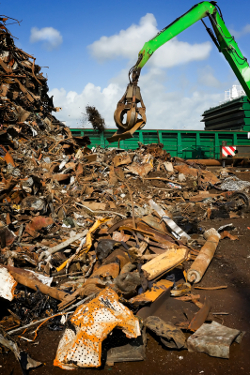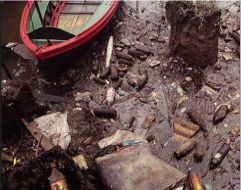New York's Garbage Cruise

The garbage, litter, trash, rubbish from Islip, Long Island, NY, and other New York boroughs and townships traveled six thousand miles along the way. I about 5 months of traveling the famous boat pulled into the dock still loaded with the same amount of garbage it had started with. The story triggered a lot of headlines and debates. The funny if not serious and sad Garbage Cruise story made history.
How the famous Garbage Cruise was originated? It all started a few moths before the boat cast off the pier when New Your State officials declared that their landfills-garbage dumps-were full. The decisions was made not to enlarge landfills since stinky air, methane, insects and rodents generated by the garbage dumps were posing a serious threat to citizens health.
The local Islip Township officials announced that they would accept residential trash only. Commercial businesses would have dispose of their waste somewhere else hauling commercial garbage by roll off containers or dump truck, sometimes many miles away.
A good idea goes to waste
A proposed solution came from a head of a construction company in Bay Minette, Alabama. The man named Lowell Harrelson, heard about the situation in Islip. He came up with an idea of conducting and experiment with the hop to turn trash into cash.
The idea was to deliver the stinky load and deposit the trash on Radio Island, at the port of Morehead City and let the garbage sit long enough to give off methane gas which builds up underneath garbage when organic matter decays without oxygen. Then they would extract the gas and sell it for a profit.
The chemical industry uses methane, which makes up a large part of natural gas, as a base material for many other chemicals.
After agreements with Islip and Jones County officials were complete, Harrelson put his plan into action. First he hired people to tie the trash into big bundles or bales, load it onto a barge, and then hitch the litter barge to the leased tugboat Break of Dawn.
Refuse refused
Next, Captain Duffy St. Pierre and his tugboat crew were given their orders. They were to haul the barge down the Atlantic Coast from New York to North Carolina, then deposit the bales of trash on Radio Island, as agreed. Everything happened according to plan until they pulled into port at Morehead City. North Carolina officials had changed their minds. They were no longer willing to accept the bulging bales.
So the tugboat and barge pulled out of the North Carolina port and continued the cruise along the coast in search of a place to drop off the stinky load. But the search was not to end quickly or easily.
What began as a simple experiment soon turned into an odyssey at sea that eventually attracted worldwide attention. Mississippi officials said no to the litter barge, and so did officials
from Alabama, Florida, Texas, and Louisiana. Some were more
serious than others. Florida's governor Bob Martinez did not find
the incident one bit funny. He had the power to shut out the teeming refuse, and he used it. All Florida ports were closed to the litter laden Mobro.
The governor of Louisiana, on the other hand, jokingly threatened to call out the National Guard if the captain and crew didn't get on their way. But as it turned out, he had good reason to refuse the refuse. When the weather-beaten barge pulled into the delta town of Venice, Louisiana's Department of Environmental Quality assigned inspectors to examine the festering bales.
Most of the contents were paper, but they also found syringes, bedpans, and other hospital items that could pose a health threat. Inspectors feared the oozing garbage and trash would leak: into the river and pollute the water supply. So once more, the meandering Mobro was asked to sail on. Next, Captain St. Pierre maneuvered the barge farther south. Perhaps a foreign country would be willing to take the unwanted trash. But alas, Mexico, the Bahamas, and tiny Belize in Central America closed their ports, as well. In fact, Belize took no chances. It even mobilized its small-plane Air Force against the barge of garbage. Newspaper headlines soon proclaimed the bales of trash "the garbage without a country!"
Home sweet home
By early May the gar-barge had no choice but to head home. Islip officials did not exactly spread out a welcome mat. However, they did agree to let the barge unload at Islip-just this once-but only after the garbage had passed inspection at Long Island City and was taken by truck across Queens.
Citizens were not so sympathetic. Some Islip residents waved signs that read, "Ban the Barge!" And Claire Shulman, president of the borough of Queens, stopped the barge from docking in her borough by court order.
On May 16, the tugboat and barge pulled into New York Harbor. Within minutes Captain Duffy St. Pierre and his crew charged off the boat and up the ramp, tired, hungry, smelly, and almost desperate. They were interested in only two things-a good hot shower and a home-cooked meal!
They hadn’t been off the boat in over fifty days. St. Pierre had meant business when he told reporters that he had planned to dock, no matter what. "I think they'll have to have gunboats to stop me," he said. And that's exactly how New York City Mayor Ed Koch responded to their homecoming. Police Department launches with armed guards ordered the tug and barge to leave. Rejected once again, the Mobro and the Break of Dawn moved to Gravesend Bay, off Brooklyn, where they lay at anchor until further notice.
During the next three months, the Mobro became a popular tourist attraction, competing with such famous sites as the Empire State Building and the Statue of Liberty. Brooklyn residents lined the highways, peering at the famous tug and barge through telescopes. From the water, excursion boats and fancy yachts from nearby states coded the famous litter barge.
The Mobro gained television fame when Phil Donahue and Johnny Carson devoted time to the barge and its unexpected cruise to the Caribbean. Donahue stepped aboard the barge during one of his hourlong talk shows and hailed the bales as "the most famous three thousand tons of garbage in the history of the universe."
The bulging gar-barge, once an ordinary flat-bottomed boat, was fast becoming a national celebrity!
First-class burial
After the return of the Mobro, state and city officials struggled with where to put the trash and who should pay for it. Then on August 10, a state superior court judge in Brooklyn said the city could go ahead with its plan to burn the garbage. Judge Dominic Lodato said that Brooklyn officials and community groups had not proved that burning the trash and trucking the ash to the landftll on Long Island would be a health hazard or would violate state environmental laws.
Plans were made. Workers would dock the barge near the incinerator. There the city would build a ramp for unloading the bales, and then sanitation workers would break open the bundles to inspect them for infectious or hazardous materials. Next, the world-famous refuse would be burned in a Brooklyn incinerator.
The four hundred tons of leftover ash would be buried at last in an Islip landftll-the very same landfill that originally turned it away!
On the morning of September 1, sanitation workers pulled on their protective suits and masks. Slowly they began snipping at the bulging bales. No one knew quite what to expect. The barge had roamed the ocean for months. All sorts of strange things could be lurking inside the soggy bundles.
After the last ties were snipped, the five inspectors stepped aside and watched a huge bulldozer break into the weather-beaten bundles. Paper and cardboard spilled out. Then plastic forks and spoons fell to the ground. Not much else was-recognizable. Then suddenly, to everyone's surprise, out popped a huge family of-crickets-at least a million crickets who had come along for the ride!
That didn't discourage eager spectators or uniformed officials. The garbage barge was still a national celebrity, and people stood around in large numbers with great expectation to watch the ceremony. Vito Turo, New York's Sanitation Commission's chief spokesman, played it for all it was worth. He offered Garbage Barge ‘87 Souvenirs actual trash from the barge itself. Free! Free samples of a project that, by the time it was over, would have cost owner Harrelson and the state of New York more than one million dollars.
Brendan Sexton, also from the Sanitation Commission, finally called a halt to all the fanfare. "I appreciate that this brought to people's attention that there is a waste disposal problem in America, but enough is enough. It's time to end it."
And what became of trash owner Lowell Harrelson and his waste disposal experiment? He told reporters he felt slightly depressed because he had hoped his idea would work out. "But I'm not completely turned off from the garbage business," he added. His experience with the gar-barge, Harrelson admitted, had helped him learn more about how people in business think and behave-information he expected would be useful in the future.
Cartoon or crisis? The voyage of the Mobro was funny in many ways. But it was also serious because it pointed to one of the most pressing problems facing our nation today-waste management and disposal-or, simply, how and where to get rid of our garbage. Alfred DelBello, former lieutenant governor of New York, sees the garbage odyssey as "a national embarrassment." He said that citizens could view it as material for a cartoon, or they can see it for what it is. "The people of the world watch America unable to cope with its most basic problem-its own waste," he said in an article for American City and County.
For citizens who are willing to look at the truth behind the odyssey of the garbage barge, there are many lessons. We can learn much about our resources and the way we use and often abuse them. Or we can continue to deny the problem and go on disposing of our trash and garbage with little thought for the impact it will have on the quality of our lives. In Islip and hundreds of other United States towns, overcrowded landfills, plots of land set aside for dumping trash and garbage, are packed with mounds of decaying garbage that threaten underground water supplies.
Big cities such as New York, Detroit, Chicago, and Miami now bum part of their garbage, which saves the water but may pollute the air.
On the West Coast, Los Angeles County's Puente Hills landfill reaches its daily quota of twelve thousand tons of trash before noon. In Michigan's Dafter township, residents face a different problem. They are fighting in court to keep outsiders from using a private dump where eighteen dead buffaloes, oil sludge from a piston-ring factory, and sixty tons of trash a day from nearby Marquette are buried in a bulging mound that has already reached its limit.
Taking a moment, we would like to thank our members for their continues support of our environment protection efforts:
- Seattle Dumpster Rentals
- Sacramento, CA Roll Off Dumpster Rentals
- Dumpster Rentals in Phoenix, AZ and Roll Off Containers Phoenix
- Kirkland, WA Dumpster Rentals
- Bellevue, WA Roll Off Dumpster Rentals .
- Published: 2013-02-13T15:53:04-08:00
- Author: Anna Krupp, Dumpsters & Roll Off Container Consultant




